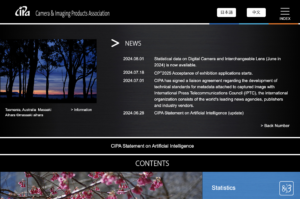Categories
Archives

The IPTC has signed a liaison agreement with the Japanese camera-makers organisation and creators of the Exif metadata standard, CIPA.
CIPA members include all of the major camera manufacturers, including Nikon, Canon, Sony, Panasonic, FUJIFILM and more. Several software vendors who work with imaging are also members, including Adobe, Apple and Microsoft.
CIPA publishes guidelines and standards for camera manufacturers and imaging software developers. The most important of these from an IPTC point of view is the Exif standard for photographic metadata.
The IPTC and CIPA have had an informal relationship for many years, staying in touch regularly regarding developments in the world of image metadata. Given that the two organisations manage two of the most important standards for embedding metadata into image and video files, it’s important that we keep each other up to date.
Now the relationship has been formalised, meaning that the organisations can request to observe each other’s meetings, exchange members-only information when needed, and share information about forthcoming developments and industry requirements for new work in the field of media metadata and in related areas.
The news has also been announced by CIPA. According to the news post on CIPA’s website, “CIPA has signed a liaison agreement regarding the development of technical standards for metadata attached to captured image with International Press Telecommunications Council (IPTC), the international organization consists of the world’s leading news agencies, publishers and industry vendors.”

The Internet Architecture Board (IAB), a Committee of the Internet Engineering Task Force (IETF) which decides on standards and protocols that are used to govern the workings of Internet infrastructure, is having a workshop in September on “AI Control”. Discussions will include whether one or more new IETF standards should be defined to govern how AI systems work with Internet content.
As part of the lead-up to this workshop, the IAB and IETF have put out a call for position papers on AI opt-out techniques.
Accordingly, the IPTC Photo Metadata Working Group, in association with partner organisation the PLUS Coalition, submitted a position paper discussing in particular the Data Mining property which was added to the IPTC Photo Metadata Standard last year.
In the paper, the IPTC and PLUS set out their position that data mining opt-out information embedded in the metadata of media files is an essential part of any opt-out solution.
Here is a relevant section of the IPTC submission:
We respectfully suggest that Robots.txt alone is not a viable solution. Robots.txt may allow for communication of rights information applicable to all image assets on a website, or within a web directory, or on specific web pages. However, it is not an efficient method for communicating rights information for individual image files published to a web platform or website; as rights information typically varies from image to image, and as the publication of images to websites is increasingly dynamic.
In addition, the use of robots.txt requires that each user agent must be blocked separately, repeating all exclusions for each AI engine crawler robot. As a result, agents can only be blocked retrospectively — after they have already indexed a site once. This requires that publishers must constantly check their server logs, to search for new user agents crawling their data, and to identify and block bad actors.
In contrast, embedding rights declaration metadata directly into image and video files provides media-specific rights information, protecting images and video resources whether the site/page structure is preserved by crawlers — or the image files are scraped and separated from the original page/site. The owner, distributor, or publisher of an image can embed a coded signal into each image file, allowing downstream systems to read the embedded XMP metadata and to use that information to sort/categorise images and to comply with applicable permissions, prohibitions and constraints.
IPTC, PLUS and XMP metadata standards have been widely adopted and are broadly supported by software developers, as well as in use by major news media, search engines, and publishers for exchanging images in a workflow as part of an “operational best practice.” For example, Google Images currently uses a number of the existing IPTC and PLUS properties to signal ownership, licensor contact info and copyright. For details see https://iptc.org/standards/photo-metadata/quick-guide-to-iptc-photo-metadata-and-google-images/
The paper in PDF format can be downloaded from the IPTC site.
Thanks to David Riecks, Margaret Warren, Michael Steidl from the IPTC Photo Metadata Working Group and to Jeff Sedlik from PLUS for their work on the paper.
Categories
Archives
- December 2025
- November 2025
- October 2025
- September 2025
- August 2025
- July 2025
- June 2025
- May 2025
- April 2025
- March 2025
- February 2025
- January 2025
- December 2024
- November 2024
- October 2024
- September 2024
- August 2024
- July 2024
- June 2024
- May 2024
- April 2024
- March 2024
- February 2024
- December 2023
- November 2023
- October 2023
- September 2023
- August 2023
- July 2023
- June 2023
- May 2023
- March 2023
- February 2023
- January 2023
- December 2022
- November 2022
- October 2022
- September 2022
- August 2022
- July 2022
- June 2022
- May 2022
- April 2022
- March 2022
- February 2022
- January 2022
- December 2021
- November 2021
- October 2021
- September 2021
- August 2021
- July 2021
- June 2021
- May 2021
- April 2021
- February 2021
- December 2020
- November 2020
- October 2020
- September 2020
- August 2020
- July 2020
- June 2020
- May 2020
- April 2020
- March 2020
- February 2020
- December 2019
- November 2019
- October 2019
- September 2019
- July 2019
- June 2019
- May 2019
- April 2019
- February 2019
- November 2018
- October 2018
- September 2018
- August 2018
- July 2018
- June 2018
- May 2018
- April 2018
- March 2018
- January 2018
- November 2017
- October 2017
- September 2017
- August 2017
- June 2017
- May 2017
- April 2017
- December 2016
- November 2016
- October 2016
- September 2016
- August 2016
- July 2016
- June 2016
- May 2016
- April 2016
- February 2016
- January 2016
- December 2015
- November 2015
- October 2015
- September 2015
- June 2015
- April 2015
- March 2015
- February 2015
- November 2014